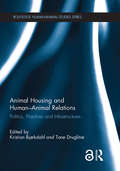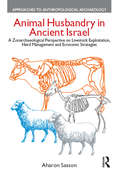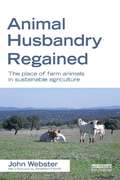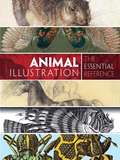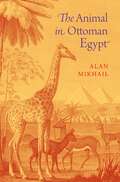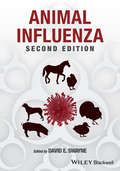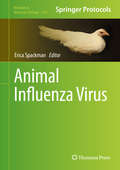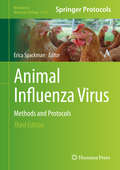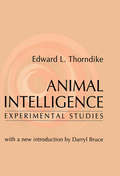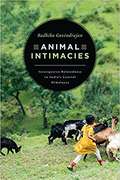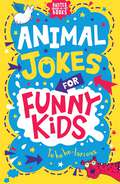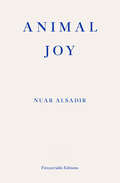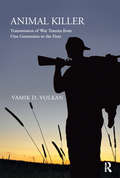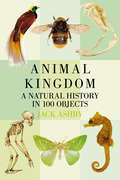- Table View
- List View
Animal Housing and Human-Animal Relations: Politics, Practices and Infrastructures (Routledge Human-Animal Studies Series)
by Kristian Bjørkdahl Tone DruglitrøThis book provides an in-depth investigation into the practices of animal housing systems with international contributions from across the humanities and social sciences. By attending to a range of different sites such as the zoo, the laboratory, the farm and the animal shelter, to name a few, the book explores material technologies from the perspective that these are integrated parts of a larger biopolitical infrastructure and questions how animal housing systems, and the physical infrastructures that surround central human-animal practices, come into being. Chapter 11 of this book is freely available as a downloadable Open Access PDF under a Creative Commons Attribution-Non Commercial-No Derivatives 3.0 license. https://s3-us-west-2.amazonaws.com/tandfbis/rt-files/docs/Open+Access+Chapters/9781138854116_oaChapter11.pdf
Animal Husbandry in Ancient Israel: A Zooarchaeological Perspective on Livestock Exploitation, Herd Management and Economic Strategies
by Aharon SassonAnimals have been used to human advantage for thousands of years. 'Animal Husbandry in Ancient Israel' presents an analysis of caprines and cattle husbandry in the Southern Levantine Bronze and Iron Age. The book employs key methodological approaches - comparative analysis, taphonomy, Geographic Information System spatial analysis, and ethnographic studies - to challenge prevalent views on the Southern Levantine ancient economy. 'Animal Husbandry in Ancient Israel' argues that the key concern of nomadic, rural and urban populations was survival - the common household maintained a self-sufficient economy - rather than profit, specialization or trade. The book will be of value to all those interested in the dynamic relationship between humans and animals in ancient Israel.
Animal Husbandry in Ancient Israel: A Zooarchaeological Perspective on Livestock Exploitation, Herd Management and Economic Strategies
by Aharon SassonAnimals have been used to human advantage for thousands of years. 'Animal Husbandry in Ancient Israel' presents an analysis of caprines and cattle husbandry in the Southern Levantine Bronze and Iron Age. The book employs key methodological approaches - comparative analysis, taphonomy, Geographic Information System spatial analysis, and ethnographic studies - to challenge prevalent views on the Southern Levantine ancient economy. 'Animal Husbandry in Ancient Israel' argues that the key concern of nomadic, rural and urban populations was survival - the common household maintained a self-sufficient economy - rather than profit, specialization or trade. The book will be of value to all those interested in the dynamic relationship between humans and animals in ancient Israel.
Animal Husbandry Regained: The Place of Farm Animals in Sustainable Agriculture
by John WebsterThe farming of animals for meat and milk confronts a stark dilemma. While world demand from a growing and more affluent human population is increasing rapidly, there are strong counter-arguments that we should eat less meat and pay more attention to environmental protection, animal welfare and human health and well-being. The aim of this book is to identify and explain the causes and contributors to current problems in animal husbandry, especially those related to 'factory farming', and advance arguments that may contribute to its successful re-orientation. Husbandry is considered in its broadest sense, namely the productive and sustainable use of the land for the good of all (plants, humans and other animals). The first part of the book outlines principles and arguments necessary to engage with current problems: depletion of natural resources and destruction of environment, animal welfare, food and health, fair trade and sharing resources. These arguments are illustrated by examples and sufficient evidence to justify the argument without obscuring the message. The second part presents a series of constructive proposals for change and development in animal husbandry, both in the developed world and subsistence agriculture. These include more integrated crop and livestock farming systems, the ethics of animal welfare and environmental management, and the evolution of a new social contract whereby the rights of the people to a fair share of good, safe food and a green and pleasant land are matched by a shared responsibility to preserve these things.
Animal Husbandry Regained: The Place of Farm Animals in Sustainable Agriculture
by John WebsterThe farming of animals for meat and milk confronts a stark dilemma. While world demand from a growing and more affluent human population is increasing rapidly, there are strong counter-arguments that we should eat less meat and pay more attention to environmental protection, animal welfare and human health and well-being. The aim of this book is to identify and explain the causes and contributors to current problems in animal husbandry, especially those related to 'factory farming', and advance arguments that may contribute to its successful re-orientation. Husbandry is considered in its broadest sense, namely the productive and sustainable use of the land for the good of all (plants, humans and other animals). The first part of the book outlines principles and arguments necessary to engage with current problems: depletion of natural resources and destruction of environment, animal welfare, food and health, fair trade and sharing resources. These arguments are illustrated by examples and sufficient evidence to justify the argument without obscuring the message. The second part presents a series of constructive proposals for change and development in animal husbandry, both in the developed world and subsistence agriculture. These include more integrated crop and livestock farming systems, the ethics of animal welfare and environmental management, and the evolution of a new social contract whereby the rights of the people to a fair share of good, safe food and a green and pleasant land are matched by a shared responsibility to preserve these things.
Animal Illustration: The Essential Reference
by Carol Belanger GraftonComprehensive and entertaining, this volume comprises the greatest works in animal illustration from the Middle Ages through the twentieth century. The chronological presentation of hundreds of black-and-white and color images begins with a medieval illuminated manuscript by the Limbourg brothers and the Renaissance works of Albrecht Dürer and other artists from the first centuries of printing. Subsequent illustrations include the seventeenth-century real and imaginary animals of Matthäus Merian and the unique eighteenth-century compilations of Albertus Seba. Nineteenth-century images are drawn from sources as diverse as J. G. Heck's Bilder Atlas; the prints of Georges Baron Cuvier; William Jardine's 40-volume Naturalist's Library; bird illustrations by John James Audubon, Alexander Wilson, Edward Lear, and many others; extraordinary butterfly and insect images by E. A. Seguy, as well as animal illustrations from Victorian chromolithograph die cuts. The exquisite Edwardian bestiary of the Detmold brothers brings the collection into the twentieth century, and ends with the imagery of contemporary dinosaur artist James Gurney.Detailed bibliographical information concerning every source—including biographical details of each artist—makes this collection a vital reference tool as well as a splendid resource of outstanding animal illustrations. Students of graphic art and illustration, as well as graphic designers and advertising professionals, will prize this treasury of material from many rare historic sources.
The Animal in Ottoman Egypt
by Alan MikhailSince humans first emerged as a distinct species, they have eaten, fought, prayed, and moved with other animals. In this stunningly original and conceptually rich book, historian Alan Mikhail puts the history of human-animal relations at the center of transformations in the Ottoman Empire from the sixteenth to the nineteenth centuries. Mikhail uses the history of the empire's most important province, Egypt, to explain how human interactions with livestock, dogs, and charismatic megafauna changed more in a few centuries than they had for millennia. The human world became one in which animals' social and economic functions were diminished. Without animals, humans had to remake the societies they had built around intimate and cooperative interactions between species. The political and even evolutionary consequences of this separation of people and animals were wrenching and often violent. This book's interspecies histories underscore continuities between the early modern period and the nineteenth century and help to reconcile Ottoman and Arab histories. Further, the book highlights the importance of integrating Ottoman history with issues in animal studies, economic history, early modern history, and environmental history. Carefully crafted and compellingly argued, The Animal in Ottoman Egypt tells the story of the high price humans and animals paid as they entered the modern world.
The Animal in Ottoman Egypt
by Alan MikhailSince humans first emerged as a distinct species, they have eaten, fought, prayed, and moved with other animals. In this stunningly original and conceptually rich book, historian Alan Mikhail puts the history of human-animal relations at the center of transformations in the Ottoman Empire from the sixteenth to the nineteenth centuries. Mikhail uses the history of the empire's most important province, Egypt, to explain how human interactions with livestock, dogs, and charismatic megafauna changed more in a few centuries than they had for millennia. The human world became one in which animals' social and economic functions were diminished. Without animals, humans had to remake the societies they had built around intimate and cooperative interactions between species. The political and even evolutionary consequences of this separation of people and animals were wrenching and often violent. This book's interspecies histories underscore continuities between the early modern period and the nineteenth century and help to reconcile Ottoman and Arab histories. Further, the book highlights the importance of integrating Ottoman history with issues in animal studies, economic history, early modern history, and environmental history. Carefully crafted and compellingly argued, The Animal in Ottoman Egypt tells the story of the high price humans and animals paid as they entered the modern world.
Animal Influenza
by David E. SwayneAnimal Influenza, Second Edition is a comprehensive text on animal influenza. Organized by species, coverage includes avian, swine, equine and mammals, with each section including data on influenza viruses, the infection and disease they cause, and strategies used in control. Covers the full range of topics within avian, swine, equine and mammalian influenzas in one comprehensive and authoritative text Provides a summarization of peer-reviewed and empirical data on influenza viruses, the infection, and diseases they cause Discusses strategies used in control of the disease Leading experts are drawn together to provide an international and multi-disciplinary perspective Fuses latest developments in basic scientific research with practical guidance on management of the disease
Animal Influenza
by David E. SwayneAnimal Influenza, Second Edition is a comprehensive text on animal influenza. Organized by species, coverage includes avian, swine, equine and mammals, with each section including data on influenza viruses, the infection and disease they cause, and strategies used in control. Covers the full range of topics within avian, swine, equine and mammalian influenzas in one comprehensive and authoritative text Provides a summarization of peer-reviewed and empirical data on influenza viruses, the infection, and diseases they cause Discusses strategies used in control of the disease Leading experts are drawn together to provide an international and multi-disciplinary perspective Fuses latest developments in basic scientific research with practical guidance on management of the disease
Animal Influenza Virus: Methods And Protocols (Methods in Molecular Biology #1161)
by Erica SpackmanAvian Influenza Virus, Second Edition aims to provide the essential methods used in working with animal influenza viruses, and to compile more advanced information that will guide the user in designing influenza studies. Influenza A viruses are among the most important pathogens for humans, food animals and companion animals. Research and diagnostics with animal influenza viruses are critical to animal health and it should be recognized that the needs and goals of animal agriculture and veterinary medicine are not always the same as those of public health. This volume sorts out the differences in the structure of the poultry, swine and equine industries, the biological differences of influenza virus from each animal group, and provides host, strain and lineage specific guidance and procedures. Written in the successful Methods in Molecular Biology series format, chapters include introductions to their respective topics, lists of the necessary materials and reagents, step-by-step, readily reproducible protocols, and notes on troubleshooting and avoiding known pitfalls.Authoritative and accessible, Avian Influenza Virus, Second Edition seeks to serve both professionals and novices with its well-honed methodologies in an effort to further our knowledge of these important pathogens.
Animal Influenza Virus: Methods and Protocols (Methods in Molecular Biology #2123)
by Erica SpackmanThis third edition aims to provide new and updated methods on animal influenza viruses as well as more advanced protocols that will guide the reader in designing research. Chapters detail influenza in peridomestic animals, marine mammals, savian influenza, swine influenza, equine influenza, hemagglutination, genome sequencing, and influenza in other mammals. Written in the highly successful Methods in Molecular Biology series format, chapters include introductions to their respective topics, lists of the necessary materials and reagents, step-by-step, readily reproducible laboratory protocols, and tips on troubleshooting and avoiding known pitfalls. Authoritative and cutting-edge, Animal Influenza Virus: Methods and Protocols, Third Edition aims to ensure successful results in the further study of this vital field.
Animal Intelligence: Experimental Studies
by Edward ThorndikeAnimal Intelligence is a consolidated record of Edward L. Thorndike's theoretical and empirical contributions to the comparative psychology of learning. Thorndike's approach is systematic and comprehensive experimentation using a variety of animals and tasks, all within a laboratory setting. When this book first appeared, it set a compelling example, and helped make the study of animal behavior very much an experimental laboratory science.This landmark study in the investigation of animal intelligence illustrates Thorndike's thinking on the evolution of the mind. It includes his formal statement of the influential law of effect, which had a significant impact on other behaviorists. Hull's law of primary reinforcement was closely related to the law of effect and Skinner acknowledged that the process of operant conditioning was probably that described in the law of effect.The new introduction by Darryl Bruce is an in-depth study of Thorndike's legacy to comparative psychology as well as a thorough retrospective review of Animal Intelligence. He includes a biographical introduction of the behaviorist and then delves into his theories and work. Among the topics Bruce covers with respect to Thorndike's studies are the nature of animal intelligence, the laws of learning and connectionism, implications for comparative psychology, and relation to theories of other behaviorists. Animal Intelligence is an intriguing analysis that will be of importance to psychologists and animal behaviorists.
Animal Intelligence: Experimental Studies
by Edward ThorndikeAnimal Intelligence is a consolidated record of Edward L. Thorndike's theoretical and empirical contributions to the comparative psychology of learning. Thorndike's approach is systematic and comprehensive experimentation using a variety of animals and tasks, all within a laboratory setting. When this book first appeared, it set a compelling example, and helped make the study of animal behavior very much an experimental laboratory science.This landmark study in the investigation of animal intelligence illustrates Thorndike's thinking on the evolution of the mind. It includes his formal statement of the influential law of effect, which had a significant impact on other behaviorists. Hull's law of primary reinforcement was closely related to the law of effect and Skinner acknowledged that the process of operant conditioning was probably that described in the law of effect.The new introduction by Darryl Bruce is an in-depth study of Thorndike's legacy to comparative psychology as well as a thorough retrospective review of Animal Intelligence. He includes a biographical introduction of the behaviorist and then delves into his theories and work. Among the topics Bruce covers with respect to Thorndike's studies are the nature of animal intelligence, the laws of learning and connectionism, implications for comparative psychology, and relation to theories of other behaviorists. Animal Intelligence is an intriguing analysis that will be of importance to psychologists and animal behaviorists.
Animal Intimacies: Interspecies Relatedness in India's Central Himalayas (Animal Lives)
by Radhika GovindrajanWhat does it mean to live and die in relation to other animals? Animal Intimacies posits this central question alongside the intimate—and intense—moments of care, kinship, violence, politics, indifference, and desire that occur between human and non-human animals. Built on extensive ethnographic fieldwork in the mountain villages of India’s Central Himalayas, Radhika Govindrajan’s book explores the number of ways that human and animal interact to cultivate relationships as interconnected, related beings. Whether it is through the study of the affect and ethics of ritual animal sacrifice, analysis of the right-wing political project of cow-protection, or examination of villagers’ talk about bears who abduct women and have sex with them, Govindrajan illustrates that multispecies relatedness relies on both difference and ineffable affinity between animals. Animal Intimacies breaks substantial new ground in animal studies, and Govindrajan’s detailed portrait of the social, political and religious life of the region will be of interest to cultural anthropologists and scholars of South Asia as well.
Animal Intimacies: Interspecies Relatedness in India's Central Himalayas (Animal Lives)
by Radhika GovindrajanWhat does it mean to live and die in relation to other animals? Animal Intimacies posits this central question alongside the intimate—and intense—moments of care, kinship, violence, politics, indifference, and desire that occur between human and non-human animals. Built on extensive ethnographic fieldwork in the mountain villages of India’s Central Himalayas, Radhika Govindrajan’s book explores the number of ways that human and animal interact to cultivate relationships as interconnected, related beings. Whether it is through the study of the affect and ethics of ritual animal sacrifice, analysis of the right-wing political project of cow-protection, or examination of villagers’ talk about bears who abduct women and have sex with them, Govindrajan illustrates that multispecies relatedness relies on both difference and ineffable affinity between animals. Animal Intimacies breaks substantial new ground in animal studies, and Govindrajan’s detailed portrait of the social, political and religious life of the region will be of interest to cultural anthropologists and scholars of South Asia as well.
Animal Intimacies: Interspecies Relatedness in India's Central Himalayas (Animal Lives)
by Radhika GovindrajanWhat does it mean to live and die in relation to other animals? Animal Intimacies posits this central question alongside the intimate—and intense—moments of care, kinship, violence, politics, indifference, and desire that occur between human and non-human animals. Built on extensive ethnographic fieldwork in the mountain villages of India’s Central Himalayas, Radhika Govindrajan’s book explores the number of ways that human and animal interact to cultivate relationships as interconnected, related beings. Whether it is through the study of the affect and ethics of ritual animal sacrifice, analysis of the right-wing political project of cow-protection, or examination of villagers’ talk about bears who abduct women and have sex with them, Govindrajan illustrates that multispecies relatedness relies on both difference and ineffable affinity between animals. Animal Intimacies breaks substantial new ground in animal studies, and Govindrajan’s detailed portrait of the social, political and religious life of the region will be of interest to cultural anthropologists and scholars of South Asia as well.
Animal Intimacies: Interspecies Relatedness in India's Central Himalayas (Animal Lives)
by Radhika GovindrajanWhat does it mean to live and die in relation to other animals? Animal Intimacies posits this central question alongside the intimate—and intense—moments of care, kinship, violence, politics, indifference, and desire that occur between human and non-human animals. Built on extensive ethnographic fieldwork in the mountain villages of India’s Central Himalayas, Radhika Govindrajan’s book explores the number of ways that human and animal interact to cultivate relationships as interconnected, related beings. Whether it is through the study of the affect and ethics of ritual animal sacrifice, analysis of the right-wing political project of cow-protection, or examination of villagers’ talk about bears who abduct women and have sex with them, Govindrajan illustrates that multispecies relatedness relies on both difference and ineffable affinity between animals. Animal Intimacies breaks substantial new ground in animal studies, and Govindrajan’s detailed portrait of the social, political and religious life of the region will be of interest to cultural anthropologists and scholars of South Asia as well.
Animal Intimacies: Interspecies Relatedness in India's Central Himalayas (Animal Lives)
by Radhika GovindrajanWhat does it mean to live and die in relation to other animals? Animal Intimacies posits this central question alongside the intimate—and intense—moments of care, kinship, violence, politics, indifference, and desire that occur between human and non-human animals. Built on extensive ethnographic fieldwork in the mountain villages of India’s Central Himalayas, Radhika Govindrajan’s book explores the number of ways that human and animal interact to cultivate relationships as interconnected, related beings. Whether it is through the study of the affect and ethics of ritual animal sacrifice, analysis of the right-wing political project of cow-protection, or examination of villagers’ talk about bears who abduct women and have sex with them, Govindrajan illustrates that multispecies relatedness relies on both difference and ineffable affinity between animals. Animal Intimacies breaks substantial new ground in animal studies, and Govindrajan’s detailed portrait of the social, political and religious life of the region will be of interest to cultural anthropologists and scholars of South Asia as well.
Animal Intimacies: Interspecies Relatedness in India's Central Himalayas (Animal Lives)
by Radhika GovindrajanWhat does it mean to live and die in relation to other animals? Animal Intimacies posits this central question alongside the intimate—and intense—moments of care, kinship, violence, politics, indifference, and desire that occur between human and non-human animals. Built on extensive ethnographic fieldwork in the mountain villages of India’s Central Himalayas, Radhika Govindrajan’s book explores the number of ways that human and animal interact to cultivate relationships as interconnected, related beings. Whether it is through the study of the affect and ethics of ritual animal sacrifice, analysis of the right-wing political project of cow-protection, or examination of villagers’ talk about bears who abduct women and have sex with them, Govindrajan illustrates that multispecies relatedness relies on both difference and ineffable affinity between animals. Animal Intimacies breaks substantial new ground in animal studies, and Govindrajan’s detailed portrait of the social, political and religious life of the region will be of interest to cultural anthropologists and scholars of South Asia as well.
Animal Jokes for Funny Kids
by Andrew Pinder Josephine SouthonA new title in the 'Buster Laugh-a-Lot' series, this paw-some collection has hundreds of hilarious animal-themed jokes for funny kids to share.Why do dogs run in circles?Because it’s hard to run in squares!How does a lion greet other animals?"Pleased to eat you."Why are frogs always so happy?They eat whatever bugs them.Filled with over 300 hiss-terical and a-moo-sing animal jokes that will have ewe in stitches, including one-liners, ridiculous puns, tongue twisters and much more. Designed to be easy to read with wonderfully silly illustrations for extra laughs, this laugh-out-loud collection will keep jokers entertained for hours on end.
Animal Joy: A Book of Laughter and Resuscitation
by Nuar AlsadirLaughter shakes us out of our deadness. An outburst of spontaneous laughter is an eruption from the unconscious that, like political resistance, poetry, or self-revelation, expresses a provocative, impish drive to burst free from external constraints. Taking laughter’s revelatory capacity as a starting point, and rooted in Nuar Alsadir’s experience as a poet and psychoanalyst, Animal Joy seeks to recover the sensation of feeling alive and embodied. Writing in a poetic, associative style, blending the personal with the theoretical, Alsadir ranges from her experience in clown school, Anna Karenina’s morphine addiction, Freud’s unfreudian behaviors, marriage brokers and war brokers to ‘Not Jokes’, Abu Ghraib, Fanon’s negrophobia, smut, the Brett Kavanaugh hearings, laugh tracks, the problem with adjectives, to how poetry can wake us up. At the centre of the book, though, is the author’s relationship with her daughters, who erupt into the text like sudden, unexpected laughter. These interventions – frank, tender, and always a challenge to the writer and her thinking – are like tiny revolutions, pointedly showing the dangers of being severed from our True Self and hinting at ways we might be called back to it. A bold and insatiably curious prose debut, Animal Joy is an ode to spontaneity and feeling alive.
Animal Killer: Transmission of War Trauma From One Generation to the Next
by Vamik D. VolkanA psychoanalytic process from its beginning to its termination is described to illustrate crucial technical issues in the treatment of individuals with narcissistic personality organization and the countertransference manifestations such patients stimulate in the analyst. The subject of this book exhibited cruelty to confirm and stabilize his grandiosity. His internal world was a "reservoir" of the deposited image of his father figure, an individual most severely traumatized during World War II. The patient was given the task to be a mass-"killer" of animals instead of being a hunted one.This book most clearly illustrates how the transgenerational transmission of trauma takes place and how the impact of war continues in future generations. The book also provides an understanding of a special kind of psychological motivation that directs a person to use weapons for mass killing. In this era of pluralism in psychoanalysis, providing the story of a psychoanalytic case in its duration opens ways for comparison and discussion of technique and can be used as a teaching tool.
Animal Killer: Transmission of War Trauma From One Generation to the Next
by Vamik D. VolkanA psychoanalytic process from its beginning to its termination is described to illustrate crucial technical issues in the treatment of individuals with narcissistic personality organization and the countertransference manifestations such patients stimulate in the analyst. The subject of this book exhibited cruelty to confirm and stabilize his grandiosity. His internal world was a "reservoir" of the deposited image of his father figure, an individual most severely traumatized during World War II. The patient was given the task to be a mass-"killer" of animals instead of being a hunted one.This book most clearly illustrates how the transgenerational transmission of trauma takes place and how the impact of war continues in future generations. The book also provides an understanding of a special kind of psychological motivation that directs a person to use weapons for mass killing. In this era of pluralism in psychoanalysis, providing the story of a psychoanalytic case in its duration opens ways for comparison and discussion of technique and can be used as a teaching tool.
Animal Kingdom: A Natural History in 100 Objects
by Jack AshbyFrom a single beginning, countless millions of stories from the animal kingdom have – and continue to – run their course. Museum objects allow us to investigate some of those stories. Animal Kingdom journeys through both the evolutionary history of animals, and the ways that people have interpreted them in museums. Animals in museums are not only representatives of their entire species, but they also tell us something about the time in which they were collected. They provide windows into the past as well as data for the present. They embody centuries of natural ecosystems and human cultures. Through a selection of 100 objects, telling 100 stories, this beautifully illustrated book explores the diversity of animal life over the past 600 million years, and delves into some of the most exciting mechanisms in evolution. By understanding some of the key stories of how nature operates, we can gain amazing insight into the systems underlying life itself.
